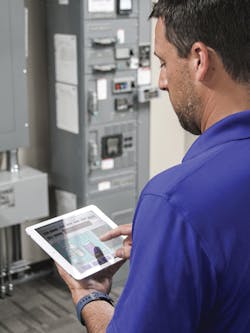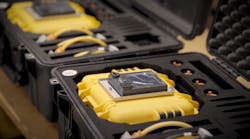No one wants to get that phone call in the middle of the night. You know the one — where your customer’s process or electrical equipment has malfunctioned or stopped working, forcing you to get up, get dressed, and drive who knows how many miles to their location on only a few hours of sleep to troubleshoot the problem. Emergency service is important to customers because they need to know that when something goes wrong with their process, electrical equipment, or technology, there will be a way to fix it so they don’t lose money on downtime. Many times, this means a person has to physically work on that particular piece of equipment.
What if there was a better way — a way in which service people could correct the problem remotely from a separate location, their own homes, or even from their own beds? Thanks to technology and the Internet of Things (IoT), this idea is now a reality, helping to shape what some are calling “technicians of the future.”
Case in Point
A Wisconsin-based, national electrical, engineering, and technology systems contractor is already starting to implement fully connected devices that allow remote troubleshooting. Recently, Faith Technologies, Menasha, Wis., partnered with a major equipment manufacturer to build a fully connected, clean energy microgrid that powers the Gordon Bubolz Nature Preserve in Appleton, Wis.
Besides the microgrid’s clean energy components, the technology operates through the IoT, and all components speak to one another. For instance, if a solar panel stops working, the system recognizes that and sends an alert to the control center as well as to a technician on a phone or iPad. Through the system, the technician can pinpoint which solar panel is malfunctioning and why.
This technology allows for more options when trying to troubleshoot and fix a problem. Instead of being forced to go to the microgrid site, that technician can either fix the problem on his device through interconnected software, or he can walk an on-site person through what needs to be done to correct the problem.
Weighing the benefits of remote monitoring Safety of personnel is typically the No. 1 priority for manufacturers and contractors. This new technology ensures technicians will no longer need to open unnecessary equipment that exposes them to potential hazards. Instead, they will be able to troubleshoot equipment from the touch of a button on a tablet in the comfort of their daily work clothes.
Another safety aspect that this technology addresses is worker fatigue. We have all heard the statistics about the negative effects of driving at night or driving while exhausted. Waking up technicians during the middle of the night — asking them to leave their family to drive across town or the state to a facility — creates a potentially dangerous situation that this technology can help eliminate.
Most service providers have an on-call rotation, which typically means the on-call technician is not familiar with the facility he needs to service during an emergency. Walking into an unfamiliar facility at night, without the proper background of how the facility operates, adds additional hazards. When you add all of these potential hazards together — lack of sleep, unfamiliar locations, and potential electrical hazards — it creates a recipe for an even larger safety concern.
If worst comes to worst, and technicians still need to travel to a physical location themselves, they are able to analyze the problem and determine possible solutions before they actually get to the job site. Not having to wait until they arrive on-site to analyze every relay, starter, and variable-frequency drive of a machine prevents unnecessary downtime and saves companies money. Having an idea of what is going on before they get to the facility allows technicians to know right where they need to go to fix the problem — or at least have a pretty good idea of what to look for when they arrive. This ultimately makes the entire process quicker and more efficient for companies and the bottom line.
Advantages of Instant Analytics
One of the largest unnecessary expenditures facilities deal with is unplanned downtime. When an operation or a plant is down, it not only loses labor hours for employees (who now need to wait around until the process is back up and running) but also lost revenue and profits from the manufactured goods. This remote troubleshooting technology helps reduce the amount of time a piece of machinery or entire facility is shut down.
Analytics reduces this amount of downtime through machine learning. Having a fully connected system means all the electrical components are communicating with each other. Machine learning through analytics will continue to monitor alarms and work to prevent those alarms in the future. A good example would be potential overcurrent situations when a certain process starts. During a fault, the analytics would capture a data point and remember that event while learning how to prevent that same event in the future.
More with Less
It’s no secret that technicians and skilled labor are stretched thin today, especially with the amount of technology that companies are installing within their locations. Companies have hundreds of pieces of equipment. In a world where the skilled trades labor market continues to dwindle, remote troubleshooting is allowing more companies to be served by a fewer number of technicians. The fact is, with the current shortage of technicians available to maintain equipment, there can be large gaps in downtime since technicians are not as readily available as they once were. With the new troubleshooting technology, a single technician can remotely service multiple locations without having to travel from business to business.
This new way of servicing equipment can also be very attractive to the younger generation of workers, who value flexible work arrangements. These jobs have adaptable work hours and can offer the ability to work from home — all with good pay. This remote troubleshooting technology actually enhances the quality of life for many employees who chose to enter the skilled trades workforce despite the decreasing numbers of people being hired into them.
By the end of 2018 or early 2019 at the latest, many companies will be using this futuristic way of troubleshooting issues at least in some capacity. Most of this technology already exists, but it’s too new for many companies to achieve full implementation just yet.
So, what’s next for this technology? By the year 2020, augmented reality (AR) is expected to be used by many companies to assist with the troubleshooting technology that is already available today. There are many ways AR will be used to help technicians.
Imagine being able to view the electrical data inside a control panel. Voltage, amperage, harmonic, and power factor data will all be readily available. The technician will be able to see what relays are open or closed and which starters are engaged — all without having to open the control panel.
While it seems like something out of a science fiction movie, this technology is just around the corner. Technicians will be able to connect, via software on their mobile devices, to any machine hooked up to the software. They will be able to correct the problem or advise someone on location regarding how to correct it, all from the comfort of their own home.
This technology also offers the ability to help less experienced maintenance technicians or production employees. With the labor shortage that is already upon us, there are a number of facilities that don’t have a well-rounded maintenance technician available for every shift. AR will have the ability to show the top two to three root causes for the machine failure. This gives the less experienced technician a solid foundation for where to start the troubleshooting process. It will also give the ability for production workers to troubleshoot without having to open up control panels that would expose them to potential hazards they haven’t been trained on.
Does this mean technicians won’t ever have to step foot outside their own homes and into a customer’s physical location? Of course not. Sometimes issues do not lie within the software and are a part of the physical mechanics of the machine. However, with more and more technology being used to run businesses, many issues can be solved through this remote method.
Each day, technology is helping our world grow and adapt while connecting us more than ever before. This is just one more way technology is connecting people to machines. Yes, it can be scary, but it also can be exciting. Nevertheless, it is the way of the future, and is changing the industry whether we’re ready or not.
Sabee is the director of power solutions for Faith Technologies in Menasha, Wis. He has more than 20 years of experience in electrical construction, electrical risk management, and project management. He can be reached at [email protected].




